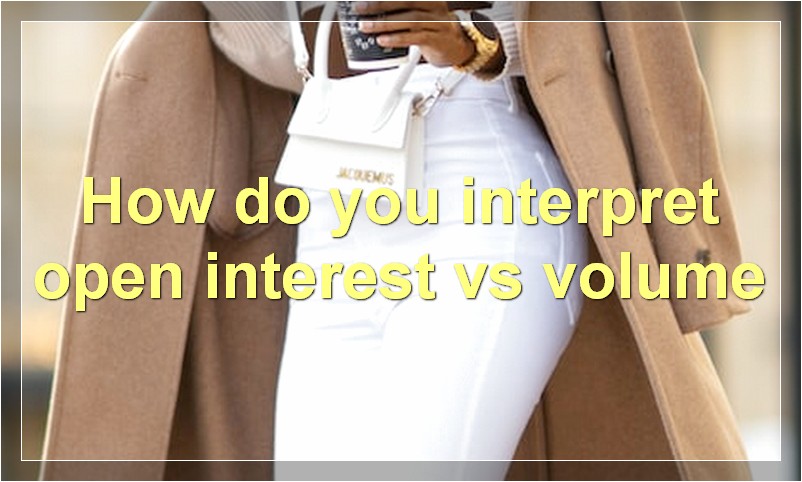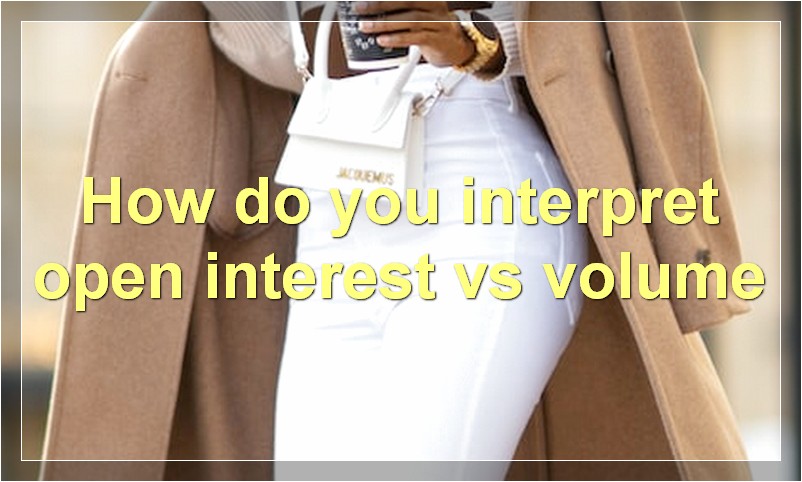If you’re new to trading, you might be wondering what the difference is between open interest and volume. Volume is the number of contracts traded in a given day, while open interest is the number of contracts that are currently outstanding.
What is the difference between open interest and volume
When it comes to tracking activity in the markets, two key metrics are open interest and volume. Both are measures of liquidity, but they provide different insights into market activity. Here’s a look at the key differences between open interest and volume.
Open interest is the number of outstanding contracts on a given security. It’s a measure of how many traders are currently holding positions in a security. Volume, on the other hand, is the number of contracts traded during a given period of time.
Open interest can be used to gauge market sentiment. An increase in open interest means that more traders are taking positions in a security, which could be a sign that prices are about to move higher. A decrease in open interest usually indicates that prices are poised to fall.
Volume, meanwhile, provides information about the intensity of trading activity. A surge in volume often signals that a major price move is about to occur. For example, if there’s an increase in volume followed by a sharp price increase, it could be a sign that buyers are aggressively pushing prices higher.
One key difference between open interest and volume is that open interest is a static metric while volume is dynamic. Open interest only changes when a new position is opened or an existing position is closed. Volume, on the other hand, changes constantly as trades are executed throughout the day.
Another difference is that open interest is specific to a particular security while volume can be measured across all securities traded in a market. This makes open interest a more useful metric for analyzing individual stocks while volume provides a broader picture of market activity.
So, what’s the bottom line? Both open interest and volume provide valuable insights into market activity, but they should be used together to get the full picture.
How do you interpret open interest vs volume

Open interest is the number of outstanding contracts that have not yet been settled. Volume is the number of contracts traded during a particular time period. The relationship between open interest and volume can be used to identify potential market trends.
If open interest is increasing while volume is decreasing, it may be an indication that the market is about to turn. This is because fewer contracts are being traded as more investors are holding on to their positions. Conversely, if open interest is decreasing while volume is increasing, it could be an indication that the market is about to reverse. This is because more contracts are being traded as investors close out their positions.
The relationship between open interest and volume can also be used to confirm price action. For example, if prices are rising and open interest is also increasing, it indicates that there is strong buying pressure in the market. Similarly, if prices are falling and open interest is also decreasing, it indicates that there is strong selling pressure in the market.
What are some common uses for open interest and volume
Open interest is the number of contracts in a given futures market that have not yet been offset by an opposite transaction. It is also used as a measure of market activity. The volume is the number of contracts traded during a given period of time.
Open interest is used as a measure of market activity because it represents the number of contracts that are still open and thus still have the potential to be traded. It can also be used to gauge the level of interest in a particular contract. For example, if the open interest in a contract is high, it may be an indication that there is a lot of interest in that contract and that it is being heavily traded. On the other hand, if the open interest is low, it may be an indication that there is not much interest in the contract and that it is not being heavily traded.
The volume is also used as a measure of market activity. It represents the number of contracts that were traded during a given period of time. The volume can be used to gauge the level of interest in a particular contract. For example, if the volume is high, it may be an indication that there is a lot of interest in that contract and that it is being heavily traded. On the other hand, if the volume is low, it may be an indication that there is not much interest in the contract and that it is not being heavily traded.
How can open interest and volume be used together to trade
Open interest is the number of outstanding contracts on a security. Volume is the number of shares traded. When open interest is high and volume is low, it may be an indication that prices are about to move higher. When open interest is low and volume is high, it may be an indication that prices are about to move lower.
What is the relationship between open interest and volume
Open interest and volume are two important indicators of market activity. Open interest represents the number of open contracts for a particular security or market. Volume, on the other hand, represents the number of units traded in a particular security or market.
The relationship between open interest and volume is often used to gauge market activity. Generally, increasing levels of both open interest and volume indicate increased market activity. However, it is important to note that there is no set rule regarding the relationship between open interest and volume. Sometimes, one indicator may increase while the other decreases.
When is it favorable to have high open interest

Open interest is the number of contracts that are held by traders in a given market. It is used as a measure of market activity, and it can be used to identify trends in the markets. When open interest is high, it means that there are more contracts being traded, and this can lead to increased volatility. High open interest can also be an indicator of a trend change, so it is important to pay attention to open interest levels when trading.
Is high volume always good
High volume does not always mean good quality. In many cases, high volume is associated with low quality. This is because companies that produce large quantities of products often do so at the expense of quality. They cut corners in order to increase production and decrease costs. As a result, their products are often inferior to those of companies that produce smaller quantities of products.
How do you identify trading opportunities using open interest and volume
Open interest and volume are both important indicators when it comes to identifying trading opportunities. Open interest is the number of contracts that are outstanding and not yet closed, while volume is the number of contracts that have been traded in a given period of time.
If open interest is increasing, it means that more people are buying contracts and are bullish on the market. This is usually a good time to buy as well. On the other hand, if open interest is decreasing, it means that people are selling contracts and are bearish on the market. This is usually a good time to sell.
Volume is also an important indicator. If volume is increasing, it means that there is more activity in the market and this can be a good time to trade. However, if volume is decreasing, it might be an indication that the market is about to turn and this could be a good time to exit a position.
How do you use open interest and volume to manage your trades
Open interest is the number of contracts that are held open in a given market. Volume is the number of contracts traded in that market. You can use these two indicators to help manage your trades by watching for changes in the amount of open interest and volume. When there is an increase in open interest, it means that more contracts are being traded and this could indicate a potential change in the direction of the market. If you see a decrease in volume, it could mean that the market is consolidating and you may want to adjust your trading accordingly.
What are some things to be aware of when trading with open interest and volume
When trading with open interest and volume, there are a few things to be aware of. First, open interest represents the number of outstanding contracts for a particular futures market. It is important to pay attention to open interest because it can give you clues about the market’s liquidity and the amount of trading activity taking place. Second, volume represents the number of contracts that are traded during a particular period of time. This is important to pay attention to because it can give you clues about the market’s activity level and the amount of buying or selling pressure in the market.

